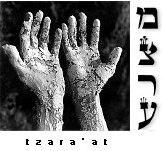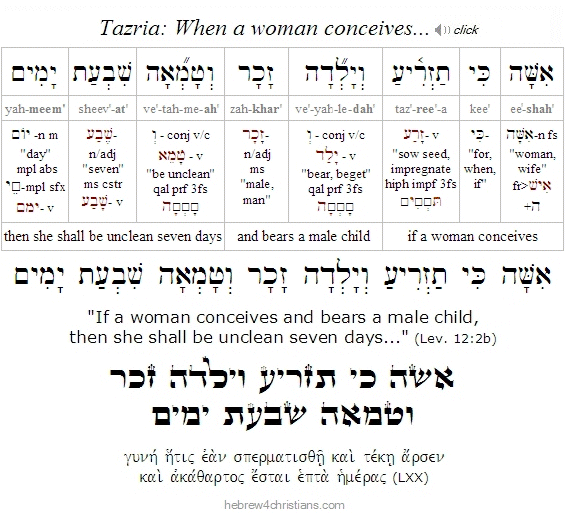Weekly Torah Reading
Parashat Tazria ("She conceives")
Click on the links to display the Scriptures:
|
Parashat |
Torah |
Haftarah |
Brit Chadashah |
|
Tazria |
Torah Reading Overview

Parashah Tazria begins with the discussion of the laws of ritual impurity and purity as it pertains to childbirth. A new mother is treated as a niddah (a menstruent woman) and is considered "impure" (tamei) regarding the sanctuary for 40 days (if a boy) or 80 days (if a girl). On the 8th day a boy must be circumcised, and once the woman is considered clean, must bring a yearling sheep as a burnt offering and a dove for a sin offering (if she is poor, two doves suffice for both offerings).
The parashah begins:



And the LORD spoke unto Moses, saying,
"Speak to the people of Israel, saying, 'If a woman conceives and bears a male child,
then she shall be unclean seven days. As the days of menstruation
so she shall be unclean.' (Leviticus 12:1-2)
Circumcision: Brit Milah
The rite of circumcision goes back to the covenant the LORD made with Avraham Avinu (Gen. 17:9-14) when the LORD commanded that a Jewish baby boy must undergo brit milah (circumcision) on the eighth day after he is born - regardless of whether the 8th day is yom tov (a holiday) or falls on Shabbat (Lev. 12:3). [For the blessing, click here]. Only after the boy has been circumcised is he given his Jewish name.
According to some Jewish traditions, God ascribes parents who perform brit milah with zechut (merit) similar to Abraham's when he offered up Isaac upon the altar.
Korbanot for Birth
In the days of the mishkan (and later the Temple), the new mother of the baby was required to offer korbanot (sacrifices) for the delivery of her child. If she was wealthy, she would bring a lamb (for olah) and a turtledove or pigeon (for chatat). If she was poor, she was allowed to offer a second bird in place of the lamb.
We read in the gospels how Miriam (Mary) faithfully observed these laws when she gave birth to her Son Yeshua the Mashiach:
And when the time came for their purification according to the Law of Moses, they brought him up to Jerusalem to present him to the Lord (as it is written in the Law of the Lord, "Every male who first opens the womb shall be called holy to the Lord") and to offer a sacrifice according to what is said in the Law of the Lord, "a pair of turtledoves, or two young pigeons." (Luke 2:22-24)
(In modern Judaism, a woman giving birth undergoes a process of purification which includes immersing in a mikveh (a naturally gathered pool of water). All male infants are to be circumcised on the eighth day of life at a brit milah ceremony.)
Tzara'at
The parashah next describes certain skin afflictions, collectively called tzara'at, that cause the afflicted person to be impure (tamei) and in a state of uncleanness (tumah). Note that tzara'at is not to be identified with leprosy (as some English translations claim), since the symptoms of tzara'at include not just the afflicted person's skin, but sometimes his clothes, pottery vessels, and house.
Tzara'at was a skin condition that could only be diagnosed by a kohen (priest), not a doctor. If white or pink patches appeared on a person's skin, the afflicted person was required to contact a kohen for an examination. If the priest detected 1) two hairs that had turned white within the spot, or 2) a piece of healthy skin in the middle of the spot, he was declared tamei (impure or unclean), and then had to follow the prescribed laws for the metzora (person affected with tzara'at); otherwise he was declared tahor (clean).
On the other hand, if the priest suspected tzara'at but was unsure, the afflicted person was quarantined and required to perform teshuvah (repentance). If a second evaluation indicated that the spot(s) had grown larger in size, the person was declared tamei and was subject to the laws for the metzora (i.e., dwelling "outside the camp" until the person was completely healed).
Tzara'at was essentially a spiritual disease - an affliction that the LORD used to help lead His people to teshuvah. The Babylonian Talmud (Erachin 15b, 16a) lists seven causes for tzara'at, including: murder, adultery, pride, theft, stinginess, a vain oath, and (most of all) for the sin of lashon hara.

What is Lashon Hara?
In general terms, lashon hara (לָשׁוֹן הָרָה) means "the evil tongue," but it should not be understood exclusively as saying slanderous things about others or using profanity (though that is certainly included in the concept). No, lashon hara means saying something bad about another person even if it happens to be true. In other words, lashon hara is gossip, spreading evil (even if true) reports, or expressing a critical spirit about others. Such behavior is explicitly forbidden in Lev. 19:16.
Of course there are times when a person is obligated to speak out, even though the information is disparaging (for example, while testifying under oath, speaking "righteous judgment (John 7:24), and so on). Indeed, sometimes it is the mark of a coward to refrain from speaking the truth when it is needed. However, the practice of being motzi ra (someone who speaks evil) is related to the status of metzora, the one who is afflicted with tzara'at, and therefore many of the Jewish sages have made the connection between the sin of lashon hara and the unclean condition known as tzara'at.
According to midrash, the first person to get tzara'at was Moses himself. When the LORD told Moses that he wanted to rescue Israel from bondage in Egypt, Moses told God, "they won't believe that You have sent me!" The LORD then told Moses to put his out his hand and it turned white with tzara'at -- for speaking evil about the Jews!
What happened to the metzora?
If someone was diagnosed with tzara'at, they were forced to leave all three of the camps of the Israelites: 1) the camp of the mishkan (Tabernacle) itself; 2) the camp of the Levites (and priests), and 3) the camp of all the other Israelite tribes (in the time of the Temple, the metzora had to leave all the walled cities of Israel). It was a state of total ostracism.
The metzora had to tear his clothes like a mourner, remain all alone, and cry out: "Unclean! Stay away! Do not become tamei (impure) because of me!" (no one was permitted to come within eight feet of him). While so isolated, the metzora would have opportunity to perform teshuvah (repentance) and find healing (as explained in the following parashah, Metzora).
Interestingly, as long as the affliction was spreading across the body, the person was metzora and therefore tamei (unclean), but if the tzara'at (finally) covered the person from head to toe, he was to be considered "clean" (Lev. 13:12-13). In other words, in some cases the metzora needed to be entirely covered with their affliction before they were set free, and this further reminds us of our need to be fully identified with the death of Yeshua in order to experience the resurrection life... It is only by understanding how radical the need for our deliverance that Yeshua's healing touch can be manifest.
Haftarah Reading Overview
The Haftarah reading for Tazria includes two vignettes from the ministry of the prophet Elisha, both of which picture our Mashiach Yeshua. In the first story, we read how a 22 loaves of bread were miraculously multiplied to feed 2,200 men, and in the second story we read how the Syrian captain Naaman was healed of tzara'at (or skin disease). Interestingly, in the gospels we read of how Jesus multiplied the loaves of bread for the people (John 6:8-13) and cleansed a leper (Matt 8:1-4). Yeshua even referred to the healing of Naaman to demonstrate to that God loves and heals people from other nations, and not only Jews (see Luke 4:27-28).
Brit Chadashah Overview
The New Testament reading for parashat Tazria includes reference to the two miracles that Yeshua the Mashiach performed just as Elisha the prophet did in the Haftarah readings (namely the miracle of the feeding of the multitude from the five loaves of bread and the healing of the one afflicted with tzara'at).
The healing by Yeshua is paradoxical, since anyone who touches someone afflicted with tzara'at became (ritually) unclean themselves, and yet we know that Yeshua was entirely without sin or impurity. He alone is the Healer of our uncleanness before God, and through His touch we are made acceptable for true spiritual worship. Thank the LORD God of Israel! The Lord Yeshua visits and heals us outside the camp!
It is the exclusive prerogative of the LORD God of Israel to "touch" those afflicted with tzara'at and heal them based on their teshuvah, and in like measure, Yeshua entered the "leper colony" of humanity to heal those who cried out to Him. He is the same yesterday, today, and forever, and His love reaches down to those who are afflicted and oppressed on account of their uncleanness. If you call upon Him, He will likewise touch you and restore you to fellowship with God.
Blessing:

based on the Torah portion
 |
- Lev. 12:2b Hebrew page (pdf)
For Further Study:
- Shabbat Table Talk for Tazria (pdf download)
- Priests and Lepers...
- Pride and Affliction
- The Trouble of Tzara'at
- Shemirat Ha'Lashon
- Words and Healing
- Atonement and Blood
- Purification and Healing...
- Shabbat HaChodesh (leap years)
- The Holiday of Passover
- Parashat Metzora (combined with Tazria)
- Keeping Kosher - How close a look?
- The Leper Messiah
- Countdown to Shavuot
Hebrew Audio Files:
Click the following links to hear the desired chapters read from this week's Torah:
|
|
Online Hebrew-English text (offsite resource)
Hebrew for Christians
Copyright © John J. Parsons
All rights reserved.